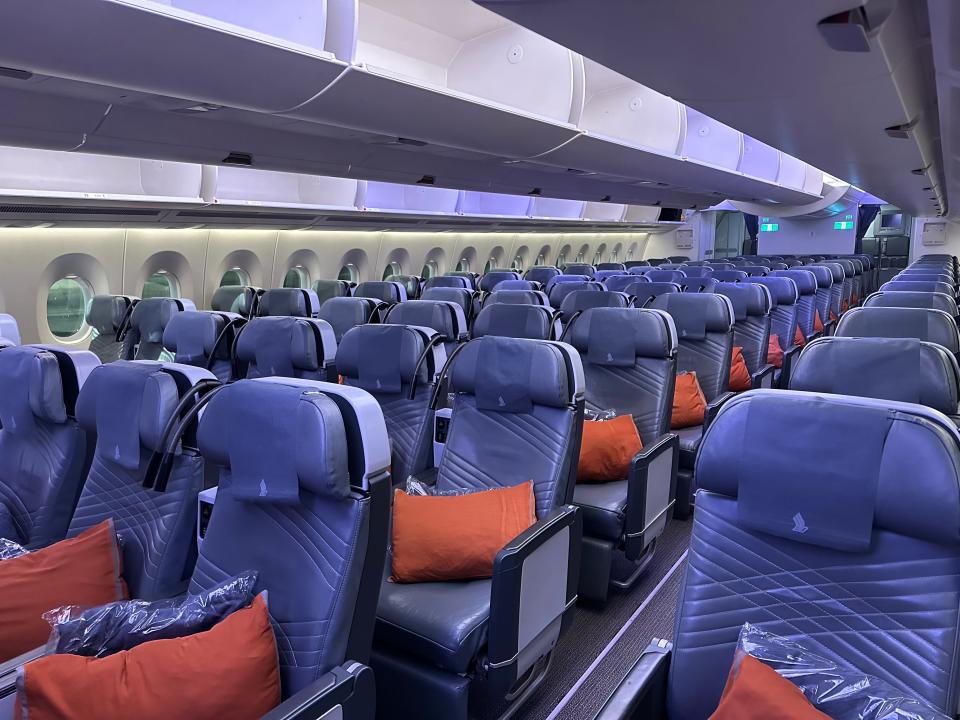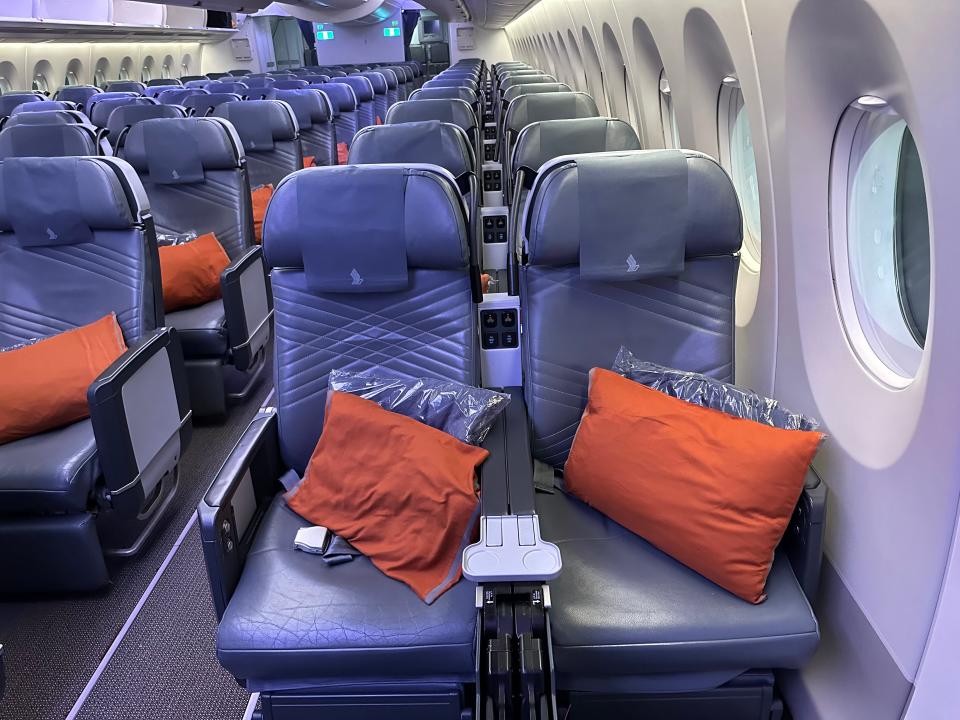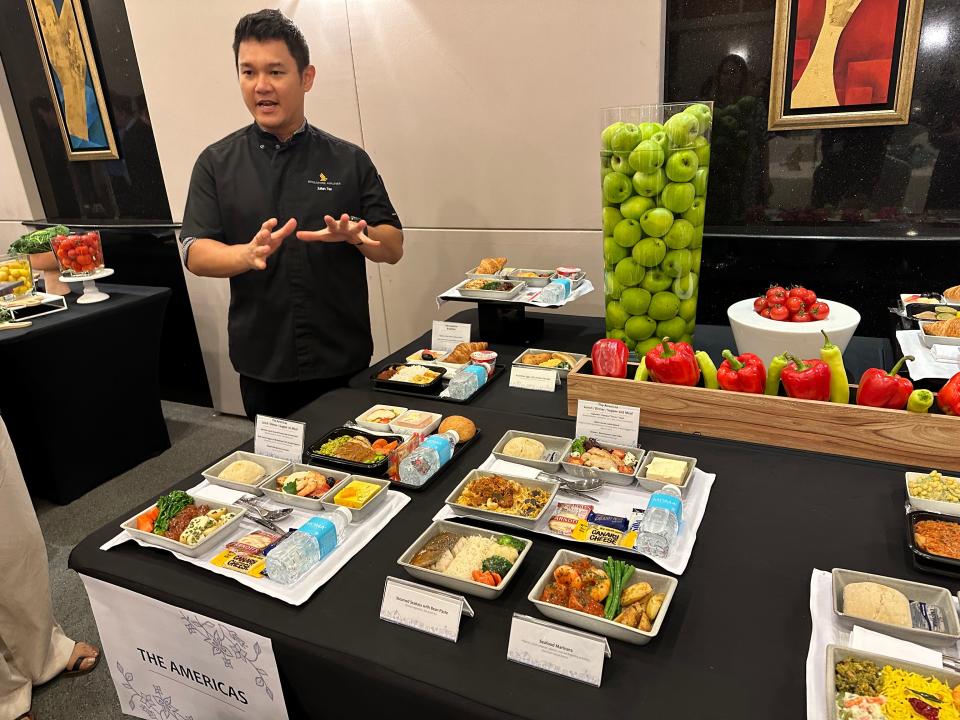This airline updated its premium economy service: How that impacts your next long-haul trip
Singapore Airlines unveiled an overhauled cabin service for its premium economy passengers earlier this month, and it’s part of a broader trend.
Long-haul premium economy is becoming increasingly important to airlines. That’s partly because leisure travelers have been willing to splurge more on vacations in recent years and business travel still hasn’t fully recovered to its pre-pandemic demand levels.
Demand for premium economy is increasing as travelers become more familiar with what to expect, which makes competition for those midmarket dollars more intense. Carriers around the globe are aware of the growing interest and are increasingly investing in the cabin class.
What is premium economy?
In this case, premium economy refers to the long-haul airline product that sits between standard economy and business class. Confusingly, many airlines also call economy seats that have extra legroom “premium economy” on domestic flights, but here, the term refers to a separate cabin with larger seats and often elevated service.
“Premium economy is the 21st-century version of business class. Business class emerged in the 1980s as an interim cabin between standard economy and first class, and now premium economy is an interim cabin between standard economy and business class,” Henry Harteveldt, president of Atmosphere Research, a travel industry analytics firm, told USA TODAY. “It’s available to travelers at a much lower cost than business class may be.”

What travelers should expect when flying premium economy
Joe Lai, a physician in Charlotte, North Carolina, and American Airlines frequent flyer, told USA TODAY that he finds premium economy is often a better overall experience than flying in coach.
“Generally better seats, that’s kind of the biggest plus of that, just being able to relax, throw my feet up – with shoes on preferably,” he said. “Sometimes upgraded food options, alcohol, things like that.”
Premium economy on long-haul flights usually has larger seats than economy as Lai mentioned, with more legroom, possibly more padding, and often a more elaborate cabin service compared to the standard economy offering.
Singapore Airlines, for example, serves its premium economy meals in porcelain dishware with metal cutlery.
But as Harteveldt said, premium economy is meant to be a bridge between standard economy and business class, not a competing product for the fancier cabins.
“It is definitely better, tangibly better than standard coach,” he said, but “passengers should not expect a luxury experience in premium economy. It does not offer the same level of comfort, privacy, or attention that you find in business class.”

For airlines, it can be tricky to find the right balance between expanding comfort and service without pirating their own more premium demand.
“How do they create a product that is good enough to tempt people to trade up from economy but not so good that people trade down from business class?” Harteveldt said. “When airlines introduced lie-flat seats in business class, they made first class almost irrelevant.”
He added that different airlines think of their premium economy cabins differently, even as the seats most carriers use are becoming more or less standardized across the industry.
“It’s interesting to see where airlines place the emphasis: is it on the economy side or the premium side?” Harteveldt said. “Some airlines are going to offer above-average legroom in their premium economy seating, they could have fewer seats across the cabin than they otherwise might. Some airlines are going to say, ‘look this is certainly better than economy, but we’re not going to have a dedicated restroom for you, we’re not going to have flight attendants that are dedicated to your cabin.’ ”

For those perks, Harteveldt said, travelers can typically expect to pay about 50% more than the regular economy fare on the same flight.
Lai said he often seeks opportunities to upgrade to premium economy, especially on longer flights.
On a recent trip to New Zealand, he paid just $250 to upgrade to premium economy from extra-legroom economy seats. He said the cost was “absolutely worth it,” especially because the extra legroom and bigger seats allowed him to sleep more easily.
Why premium economy matters to airlines
Premium economy has become increasingly important to airlines’ bottom lines coming out of the pandemic.
“A lot of people have been booking the premium cabins pretty quickly as well, so we’ve seen a lot of demand for the premium cabins coming out of COVID,” Siva Govindasamy, Singapore Airlines’ divisional vice president of public affairs said at a press event unveiling the carrier’s new premium economy service concept in Singapore earlier this month. “Premium economy, specifically, has been quite popular with our customers since we launched it in 2015.”
For Singapore and other airlines, that popularity means spending more on attracting customers to buy premium economy seats.
“There is an increase in the premium economy investment, the budget that we have, as a result of this. We think that’s a good investment to make because that will ultimately ensure that the premium economy remains competitive and provides excellent value for our customers,” Govindasamy said. “You’ve got added amenities, more comfort, more space; now you’ve got even better meals, even better drinks and champagne. When we look at our customers’ feedback it’s about the value premium economy brings.”
Harteveldt said long-haul airlines that don’t offer competitive premium economy products risk falling behind their peer companies.
“When a critical mass of airlines start to do something the airlines that don’t offer it stand out and often in a negative way,” he said. “The fact that some airlines are expanding premium economy, adding more seats to the cabin, shows that it has been financially successful for airlines.”
Zach Wichter is a travel reporter for USA TODAY based in New York. You can reach him at zwichter@usatoday.com
This article originally appeared on USA TODAY: Why premium economy is more important to airlines, travelers than ever

